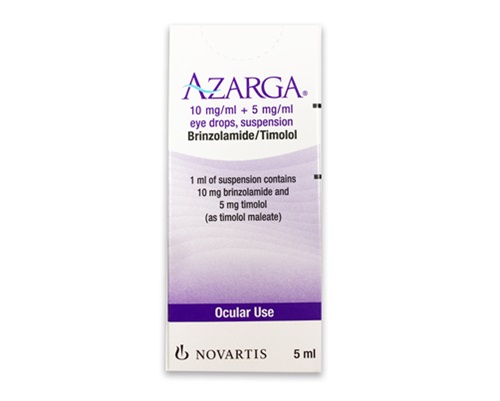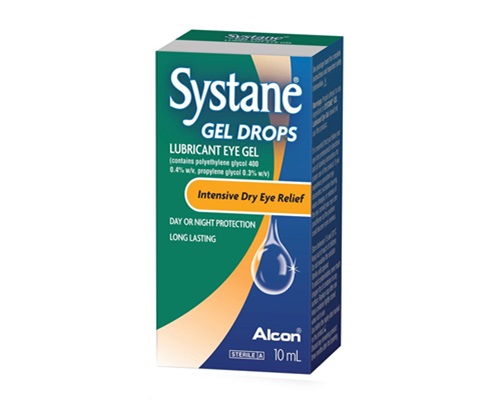Description
Trade name:
Azarga
Compound:
Each 1 ml of suspension (drops) contains:
Brinzolamide 10 mg
Timolol (as timolol maleate) 5 mg
Auxiliary components:
Benzalkonium chloride, mannitol, carbopol 974P, tyloxapol, disodium edetate, sodium chloride, hydrochloric acid (to stabilize pH), water for injection.
Properties:
Antiglaucoma combination drug. Brinzolamide and timolol reduce elevated intraocular pressure primarily by reducing the secretion of intraocular fluid, but in different ways. The combined effect of brinzolamide and timolol exceeds the effect of each substance separately in reducing intraocular pressure.
Brinzolamide is a carbonic anhydrase II inhibitor.
Timolol is a non-selective β-adrenergic receptor blocker without sympathomimetic activity. A number of studies have shown that when applied topically, timolol reduces the formation of intraocular fluid and slightly increases its outflow.
Indications:
To reduce elevated intraocular pressure in open-angle glaucoma and intraocular hypertension in patients in whom monotherapy has proven insufficient to reduce intraocular pressure.
Method of administration and dosage:
Apply locally, 1 drop into the conjunctival sac of the eye 2 times a day.
Contraindications:
Reactive respiratory diseases, including bronchial asthma, history of bronchial asthma, severe chronic obstructive pulmonary diseases; severe allergic rhinitis; sinus bradycardia; SSSU; sinoatrial block; grade II-III atrioventricular block; severe heart failure; cardiogenic shock; hyperchloremic acidosis; severe renal failure; pregnancy; lactation period (breastfeeding); childhood and adolescence under 18 years of age.
Precautions:
Brinzolamide and timolol may be systemically absorbed.
In patients with cardiovascular disease (e.g. coronary artery disease, Prinzmetal’s angina, heart failure) and hypotension, beta-blocker therapy should be critically assessed and treatment with other active substances should be considered.
Respiratory reactions, including death from bronchospasm, have been reported in patients with bronchial asthma after administration of topical beta-blockers.
Beta-blockers should be used with caution in patients with a tendency to spontaneous hypoglycemia or in patients with labile diabetes, since these drugs may mask the symptoms of acute hypoglycemia.
Beta-blockers in ophthalmic preparations may block the systemic action of beta-agonists, such as adrenaline. The anesthesiologist should be informed about the patient’s use of timolol.
When using this combination in patients taking systemic beta-blockers, it is necessary to take into account the possible mutual enhancement of the pharmacological action of the drugs both in relation to the known systemic effects of beta-blockers and in relation to the reduction of intraocular pressure.
In patients wearing contact lenses, careful monitoring of the cornea is necessary when using brinzolamide, as carbonic anhydrase inhibitors may affect corneal hydration. Close monitoring of patients with corneal disorders, such as patients with diabetes mellitus or corneal dystrophy, is recommended.
Impact on the ability to drive vehicles and operate machinery:
This combination has minor effects on the ability to drive and operate machinery.
Side effects:
Infectious and parasitic diseases: frequency unknown – nasopharyngitis, pharyngitis, sinusitis, rhinitis.
From the hematopoietic system: frequency unknown – decrease in the number of red blood cells, increase in the content of chlorides in the blood.
From the immune system: frequency unknown – anaphylaxis, systemic lupus erythematosus, systemic allergic reactions, including angioedema, local and generalized rash, hypersensitivity, urticaria, itching.
From the side of metabolism and nutrition: frequency unknown – hypoglycemia, decreased appetite.
Psychiatric disorders: uncommon – insomnia; frequency unknown – depression, memory loss, apathy, depressive mood, decreased libido, nightmares, nervousness.
From the nervous system: often – dysgeusia; frequency unknown – cerebral ischemia, cerebrovascular accident, fainting, increased signs and symptoms of myasthenia gravis, drowsiness, motor dysfunction, amnesia, memory impairment, paresthesia, tremor, hypoesthesia, ageusia, dizziness, headache.
From the organ of vision: often – blurred vision, eye pain, eye irritation; uncommon – corneal erosion, punctate keratitis, effusion into the anterior chamber of the eye, photophobia, dry eye syndrome, eye discharge, itching in the eyes, foreign body sensation in the eyes, hyperemia of the eyes, hyperemia of the sclera, increased lacrimation, hyperemia of the conjunctiva, erythema of the eyelids; Frequency unknown – increased optic disc escavation, post-filtration choroidal detachment, keratitis, keratopathy, corneal epithelial defect, corneal epithelial disorder, increased intraocular pressure, ocular deposits, corneal staining, corneal edema, decreased corneal sensitivity, conjunctivitis, meibomian gland inflammation, diplopia, decreased contrast vision, photopsia, decreased visual acuity, visual impairment, pterygium, eye discomfort, keratoconjunctivitis sicca, ocular hypoesthesia, scleral pigmentation, subconjunctival cyst, visual impairment, eye swelling, allergic eye reactions, madarosis, eyelid disorders, eyelid edema, ptosis, blepharitis, asthenopia, eyelid margin crusting, increased lacrimation.
From the side of the organ of hearing and labyrinthine disorders: frequency unknown – vertigo, tinnitus.
From the cardiovascular system: uncommon – decreased blood pressure; frequency unknown – cardiac arrest, heart failure, chronic heart failure, atrioventricular block, cardiorespiratory distress syndrome, angina pectoris, bradycardia, irregular heart rate, arrhythmia, palpitations, tachycardia, increased heart rate, chest pain, edema, hypotension, hypertension, increased blood pressure, Raynaud’s phenomenon, cold hands and feet.
From the respiratory system: uncommon – cough; frequency unknown – bronchospasm (mainly in patients with a history of bronchospastic disease), dyspnea, bronchial asthma, nosebleed, bronchial hyperreactivity, laryngeal irritation, nasal congestion, upper respiratory tract congestion, postnasal drip syndrome, sneezing, dry nose, sore throat and larynx, rhinorrhea.
From the digestive system: frequency unknown – vomiting, pain in the upper abdomen, abdominal pain, diarrhea, dry mouth, nausea, esophagitis, dyspepsia, feeling of discomfort in the abdominal cavity, feeling of discomfort in the stomach, increased peristalsis, gastrointestinal disorder, hypoesthesia and paresthesia of the oral cavity, flatulence, impaired liver function tests.
From the skin and subcutaneous tissues: frequency unknown – urticaria, maculopapular rash, generalized itching, skin thickening, dermatitis, alopecia, psoriasiform rash or exacerbation of psoriasis, rash, erythema.
From the musculoskeletal system: frequency unknown – myalgia, muscle spasms, arthralgia, back pain, pain in the extremities.
From the urinary system: frequency unknown – pain in the kidney area, pollakiuria.
From the genitals and mammary gland: frequency unknown – erectile dysfunction, sexual dysfunction, decreased libido.
Laboratory and instrumental data: frequency unknown – increased potassium levels in the blood, increased LDH levels in the blood.
General disorders: frequency not known – chest pain, pain, fatigue, asthenia, malaise, chest discomfort, abnormal sensations, anxiety, irritability, peripheral oedema.
Storage method:
Store at temperatures not exceeding 30 degrees.
After opening, store at a temperature not exceeding 25 degrees for no more than 30 days.









